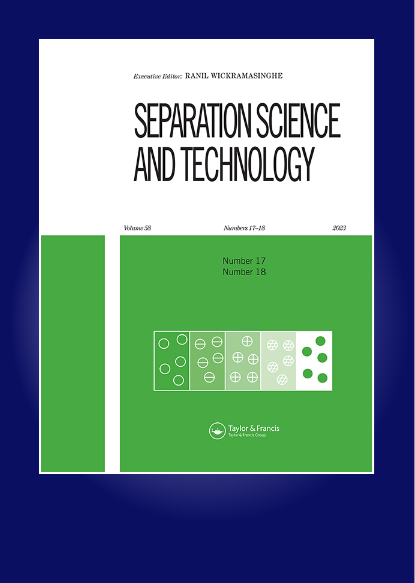去除植物制革废水中的色度和COD -工艺参数的影响、吸附机理、动力学和平衡模型
IF 2.3
4区 工程技术
Q3 CHEMISTRY, MULTIDISCIPLINARY
引用次数: 0
摘要
在本研究中,以牛头骨为原料的骨炭作为吸附剂,用于去除植物制革厂废水中的化学需氧量(COD)和色素。通过近似分析、pHpzc、FTIR、BET表面积分析和SEM-EDX光谱对炭进行了表征。考察了操作参数(pH、接触时间、吸附剂质量和温度)、吸附动力学和等温线对吸附过程的影响。在25℃条件下,50 g吸附剂在pH为2的条件下,接触60分钟,COD(77.4%)和显色(98.01%)的最佳吸附条件。采用Elovich模型和拟一阶和拟二阶模型对吸附动力学进行了分析。拟二阶模型对动力学数据的拟合效果最好。颗粒内扩散模型和Boyd模型对动力学数据的应用表明,COD和颜色在骨炭上的吸附主要受膜扩散控制。采用了Langmuir、Freundlich、Temkin和Redlich-Peterson等温线模型。Freundlich模型最好地描述了COD和颜色的吸附。对COD和颜色的最大单层吸附量分别为559.61 mg/g和2011.76 Pt-Co/g。这些结果表明,骨炭可以作为一种有效的低成本吸附剂用于废水处理。本文章由计算机程序翻译,如有差异,请以英文原文为准。
Removal of Colour and COD from vegetable tannery wastewater onto bone char– Effect of process parameters, adsorption mechanism, kinetics and equilibrium modelling
ABSTRACT In this study, bone char derived from head bones of cattle was used as an adsorbent in the removal of Chemical Oxygen Demand (COD) and colour from vegetable tannery wastewater. The char was characterized by proximate analysis, pHpzc, FTIR, BET surface area analysis and SEM-EDX spectroscopy. The effects of operational parameters (pH, contact time, adsorbent mass and temperature), the kinetics and isotherms of the adsorption process were investigated. Optimal conditions for maximum adsorption of COD (77.4%) and colour (98.01%) occurred at pH 2 after 60-minute contact time with 50 g of adsorbent at 25°C. The adsorption kinetics were analyzed using Elovich and the pseudo-first and – second-order models. The pseudo-second order model gave the best fit for the kinetic data. Application of the intra-particle diffusion and Boyd models to the kinetic data revealed that COD and colour adsorption onto the bone char were predominantly controlled by film diffusion. The Langmuir, Freundlich, Temkin and Redlich-Peterson isotherm models were applied. The Freundlich model best described the adsorption of COD and colour. The maximum monolayer adsorption capacities for COD and colour were 559.61 mg/g and 2011.76 Pt-Co/g, respectively. These results indicate that bone char can be an effective low-cost adsorbent in wastewater treatment.
求助全文
通过发布文献求助,成功后即可免费获取论文全文。
去求助
来源期刊

Separation Science and Technology
工程技术-工程:化工
CiteScore
6.10
自引率
3.60%
发文量
131
审稿时长
5.7 months
期刊介绍:
This international journal deals with fundamental and applied aspects of separation processes related to a number of fields. A wide range of topics are covered in the journal including adsorption, membranes, extraction, distillation, absorption, centrifugation, crystallization, precipitation, reactive separations, hybrid processes, continuous separations, carbon capture, flocculation and magnetic separations. The journal focuses on state of the art preparative separations and theoretical contributions to the field of separation science. Applications include environmental, energy, water, and biotechnology. The journal does not publish analytical separation papers unless they contain new fundamental contributions to the field of separation science.
 求助内容:
求助内容: 应助结果提醒方式:
应助结果提醒方式:


